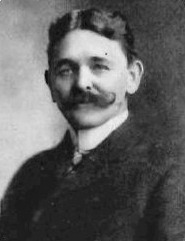Date of Death: February 6, 1946
 Evett Dumas Nix, often known as E.D. Nix, (September 19, 1861 - February 6, 1946) was a US Marshal in the late 19th century handling the jurisdiction that included the wild Oklahoma Territory, later to be the state of Oklahoma. He was first appointed in 1893, in the closing years of the Old West, during the last years of the "Hanging Judge" Parker tenure.
Evett Dumas Nix, often known as E.D. Nix, (September 19, 1861 - February 6, 1946) was a US Marshal in the late 19th century handling the jurisdiction that included the wild Oklahoma Territory, later to be the state of Oklahoma. He was first appointed in 1893, in the closing years of the Old West, during the last years of the "Hanging Judge" Parker tenure.Nix first came to Oklahoma during the Land Run of 1891, and was a Guthrie, Oklahoma businessman with many influential friends, to include rancher Oscar Halsell, who for a time employed Bill Doolin and other members of the Doolin Dalton Gang, and who was involved in the 1884 Hunnewell, Kansas Gunfight. When he was appointed to the position of U.S. Marshal he was only 32 years of age, the youngest holding that position at the time.
He took over in a very volatile time. The Doolin Dalton gang was in full swing, committing bank robberies and train robberies in Oklahoma, Texas, and Arkansas. The outlaws had a haven in Ingalls, Oklahoma, and Marshal Nix wasted no time in moving to bring the gang down. His first course of action was to organize a posse to take the outlaws in Ingalls. With Deputy Marshal John Hixon in the lead, Nix dispatched a posse of fourteen Deputy Marshals to Ingalls. On September 1, 1893, in what would become known as the Battle of Ingalls, three of his deputy marshals, Deputy Marshal Thomas Hueston, Deputy Marshal Richard Speed, and Deputy Marshal Lafeyette Shadley were killed in the ensuing gunbattle. Outlaws "Bittercreek" Newcomb, Charley Pierce, and "Dynamite Dan" Clifton were wounded, but escaped. Outlaw "Arkansas Tom" Jones was stunned and captured after dynamite was thrown at him by Deputy Marshal Jim Masterson. And a saloon owner known only as Murray was badly wounded by the marshals when he began shooting at the lawmen in defense of the outlaws.
Nix then organized a special elite group of one hundred marshals to topple the gang, including Heck Thomas, Bill Tilghman, and Chris Madsen, who became known as the Three Guardsmen. Marshal Nix was staunchly defensive of his deputy marshals, and the actions they were forced to take in order to bring the gang to justice. With Nix in support of them, the marshals began to whittle away at the gang, and by 1898 the entire Doolin Dalton gang had been wiped out with the exception of "Arkansas Tom" Jones, who was in prison. He would later be killed also by lawmen, after his release, when he returned to the outlaw life.
Two years after the Battle of Ingalls, saloon owner Murray was seeking damages for having been shot by the marshals. Marshal Nix stood in defense of his deputies, and addressed the Attorney General Judson Harmon directly on the matter, stating in part;
"Murray and other citizens catered to their trade, carried them news of the movements of deputy marshals, furnished them with ammunition, cared for their horses, permitted them to eat at their tables and sleep in their beds", and continiued "This man Murray came to the front door of the saloon either just before the outlaws left the building or just after, it is not known which. However, when he first appeared in the doorway, he had the door open just a short distance and had his winchester to his shoulder in the act of firing", he then added that "Three of the deputies seeing him in the position he was in, fired on him simultaneously. Two of the shots struck him and one broke his arm in two places." The letter is now housed in the U.S. National Archives.
U.S. Marshal Nix was dismissed from his position after an audit in 1896, after critics accused him of misusing funds. Many now believe that he was merely the victim of the fee system used at the time for payment of Deputy Marshals, and he actually did not mismanage any funds. He returned to life as a businessman in Guthrie following his dismissal, in which he saw success. In 1929 Nix co-authored a book titled "Oklahombres" with Gordon Hines, detailing much of the work that went into bringing the gang down, in addition to the hunting down of many other outlaws, to include the Jennings Gang. He also documents his youth in Kentucky, and reflects on the changes that had taken place from the 1890s to the 1920s in the way of the outlaws and the lawmen.